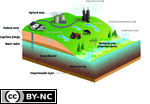Download Image
1.30 MB

1 person likes this image.
ID # 9
The Hydrologic CycleSoil properties such as texture, structure, and the nature of the pores have a great influence on water movement through soil.
STEM Standard addressed: ESS2C - The Roles of Water in Earth’s Surface Processes
Appropriate Grade Level(s)
- 6-8
- 9-12
- College-level
- Classroom Lectures
- Distance Education Classes
- Extension Presentations
- Website Information
- Introduction to Soil Science
From a soil's perspective, the water cycle begins with rain falling on the soil surface where it can soak in (infiltrate), run off the soil surface, or evaporate. Water that infiltrates moves downward through the soil pore spaces. In the root zone, water that is absorbed by roots moves through the plant to the leaves, where it is given to the atmosphere as water vapor via evapotranspiration. In the atmosphere, water vapor condenses into clouds, then forms water droplets that fall back to the soil surface as rain, sleet, snow, hail, and dew. Water not used by plants continues to move through the soil flowing laterally--eventually surfacing as a spring or seep-- or downward, eventually recharging the groundwater.
Precipitation that does not infiltrate moves across the surface as runoff, eventually entering streams, rivers, and ultimately the ocean. Water that infiltrates moves downward through the soil pore spaces. In the root zone, water that is absorbed by roots moves through the plant to the leaves, where it is given off to the atmosphere as water vapor via evapotranspiration. In the atmosphere, water vapor condenses into clouds, then forms water droplets that fall back to the soil surface as rain, sleet, snow, hail, and dew. Water not used by plants continues to move through the soil flowing laterally—eventually surfacing as a spring or seep—or downward, eventually recharging the groundwater.
Precipitation that does not infiltrate moves across the surface as runoff, eventually entering streams, rivers, and ultimately the ocean. Water that infiltrates moves downward through the soil pore spaces. In the root zone, water that is absorbed by roots moves through the plant to the leaves, where it is given off to the atmosphere as water vapor via evapotranspiration. In the atmosphere, water vapor condenses into clouds, then forms water droplets that fall back to the soil surface as rain, sleet, snow, hail, and dew. Water not used by plants continues to move through the soil flowing laterally—eventually surfacing as a spring or seep—or downward, eventually recharging the groundwater.
Peer Review: Yes
Credit this item to: Know Soil Know Life, SSSAMedia Date: 2015-12-01
Provided By: Susan Chapman
Author(s)/Creator(s)
-
* Know Soil Know Life
SSSA
Submitted By: Ms. Jenna LaFave
Keywords
- Know Soil Know Life
Comments
Please login to submit a comment.
Log In to your account
Already a member, certified, or existing customer?*
* Cookies must be accepted to log in.
Not sure if you have an account?
Check Your Email
Join Us!
Connect with members and access the information you need.
Learn more.
Ready to Join?
If you have an account, login on the left. Not sure if you have an account or need to create one? Check your email with the link above. We look forward to welcoming you.